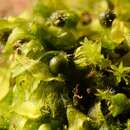pt-BR
nomes no trilho de navegação


Math o blanhigyn, di-flodau, ac un o lysiau'r afu yw Fforchlys cyffredin (enw gwyddonol: Metzgeria furcata; enw Saesneg: forked veilwort). O ran tacson, mae'n perthyn i urdd y Metzgeriales, o fewn y dosbarth Jungermanniopsida.
Mae’r rhywogaeth hon i’w chanfod yng Nghymru.
Fe'i ceir yn tyfu ar risgl ystod eang o rywogaethau coed a llwyni ac weithiau ar greigiau.[1] O'i gymharu a llysiau'r afu eraill, mae'n eitha main a thyloyw, ac mae'n ffurfio matiau gwyrdd melyn o ganghennau tua 1mm o led.
Planhigion anflodeuol bach o'r rhaniad Marchantiophyta yw llysiau'r afu. Defnyddir y term "lysiau'r afu" am un planhigyn, neu lawer. Erbyn 2019 roedd tua 6,000 o rywogaethau wedi cael eu hadnabod gan naturiaethwyr.[2] Fe'u ceir ledled y byd, mewn lleoedd llaith gan amlaf. Mae gan lawer ohonynt goesyn a dail ac maent yn debyg i fwsoglau o ran golwg.
Mae rhai rhywogaethau i'w cael yng Nghymru; gweler y categori yma.
Math o blanhigyn, di-flodau, ac un o lysiau'r afu yw Fforchlys cyffredin (enw gwyddonol: Metzgeria furcata; enw Saesneg: forked veilwort). O ran tacson, mae'n perthyn i urdd y Metzgeriales, o fewn y dosbarth Jungermanniopsida.
Mae’r rhywogaeth hon i’w chanfod yng Nghymru.
Fe'i ceir yn tyfu ar risgl ystod eang o rywogaethau coed a llwyni ac weithiau ar greigiau. O'i gymharu a llysiau'r afu eraill, mae'n eitha main a thyloyw, ac mae'n ffurfio matiau gwyrdd melyn o ganghennau tua 1mm o led.
Das Gewöhnliche Igelhaubenmoos (Metzgeria furcata) ist die in Mitteleuropa häufigste Art der Lebermoos-Gattung Metzgeria. Es kann leicht mit einigen Riccia-Lebermoosen verwechselt werden, besiedelt jedoch deutlich trockene Standorte und weist eine Mittelrippe auf, die bereits mit der Lupe erkennbar ist.
Die etwa 0,3 bis 1,4 mm breiten und bis 2 cm langen, gabelig verzweigten Thalli sind frischgrün bis gelblich grün, getrocknet weißgrün gefärbt. Sie liegen dem Untergrund zunächst oft dicht an, erst bei weiter ausgewachsenen Pflanzen stehen die Thallusspitzen etwas vom Untergrund ab. Charakteristisch sind die vielen zungenförmig linealischen Adventivsprosse, die leicht abfallen und dem Lebermoos zur vegetativen Vermehrung dienlich sind. Sie werden von den Randzellen der Lamina gebildet. Einzelne Haare befinden sich nur spärlich an den Thallusrändern verteilt, diese sind auch vereinzelt auf der Unterseite vorhanden. Die Laminazellen sind im Durchmesser etwa 30 bis 60 µm groß. Das diözische Lebermoos bildet jedoch nur äußerst selten Sporophyten aus.
Metzgeria furcata ist ein primär epiphytisches Lebermoos, das basenreiche bis schwach saure, schattige bis lichte, trockene bis frische Standorte an Borke insbesondere von Laubbäumen und Sträuchern sowie Nadelbäumen besiedelt. Seltener ist es auf nackten Baumwurzeln oder auf Gestein zu finden. Es ist ein pionierfreudiges Moos, das schnell von anderen kräftigeren Moosen überwuchert wird. Die Art ist in den gesamten gemäßigten Breiten der Nordhemisphäre sowie in Australien und auf Neuseeland verbreitet, vor allem in Gebieten mit nicht zu geringer Luftfeuchtigkeit. Seine Bestände haben in Mitteleuropa durch Luftverschmutzung in den letzten Jahren jedoch etwas abgenommen.
Das Gewöhnliche Igelhaubenmoos (Metzgeria furcata) ist die in Mitteleuropa häufigste Art der Lebermoos-Gattung Metzgeria. Es kann leicht mit einigen Riccia-Lebermoosen verwechselt werden, besiedelt jedoch deutlich trockene Standorte und weist eine Mittelrippe auf, die bereits mit der Lupe erkennbar ist.
Metzgeria furcata, the forked veilwort,[1] is a frequent liverwort growing on the bark of a wide range of tree and shrub species and occasionally on rocks.[2] It is a slim, translucent thallose liverwort forming yellow-green mats of branches about 1mm wide.
Metzgeria furcata has a midrib which is clearly visible over the rest of the thallus (which is 1mm wide), which also extends to the tip of the thallus, although without an excurrent nerve. The defining characteristic is definitely the fact that the thalli and the midrib fork at the end, which is visible on most patches. The Forked Veilwort rarely makes sporophytes, although on the underside of quite a few patches an inflorescence can be found.[2]
Found over the whole of the British Isles, but less widely in Ireland and some parts of the Scottish Highlands. Found on Scilly, Shetland, Orkney and the Isle of Man.[3]
Apometzgeria pubescens is very hairy and Metzgeria fruticulosa and M. temperata constantly have gemmae on the thalli. M. conjugata grows on rock, and M. furcata can sometimes grow on rock too, but M. conjugata has thalli that are twice as wide as M. furcata and the margins are much more turned down.[2]
Metzgeria furcata, the forked veilwort, is a frequent liverwort growing on the bark of a wide range of tree and shrub species and occasionally on rocks. It is a slim, translucent thallose liverwort forming yellow-green mats of branches about 1mm wide.
Metzgeria furcata est une espèce d'hépatiques appartenant à la classe des Jungermanniopsida ou à celle des Hepatopsida selon les classifications et à l'ordre des Metzgeriales.
On la trouve parfois comme épiphyte corticole, parfois associée à Metzgeria conjugata[1], c'est-à-dire sur les écorces d'arbres, notamment de frênes dans certaines vallées forestières humides.
Tronc humide, tronc mort humide, creux humides et zones boisées humides.
C’est une plante discrète, dont la répartition précise est mal connue.
Metzgeria furcata est une espèce d'hépatiques appartenant à la classe des Jungermanniopsida ou à celle des Hepatopsida selon les classifications et à l'ordre des Metzgeriales.
Metzgeria furcata là một loài Rêu trong họ Metzgeriaceae. Loài này được (L.) Corda mô tả khoa học đầu tiên năm 1829.[1]
Metzgeria furcata là một loài Rêu trong họ Metzgeriaceae. Loài này được (L.) Corda mô tả khoa học đầu tiên năm 1829.